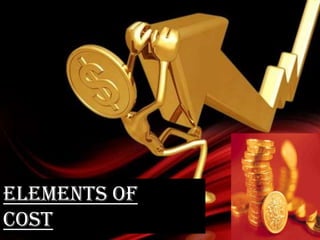
Elements of cost
- 2. The cost of a product consists of the following cost components or elements: Direct Material Direct Labour Direct Expenses Factory Overhead Selling and Distribution and Administrative Overhead
- 3. Materials: Material indicates principal substances used in production. Examples are: cotton, jute, iron-ore, and silicon. The cost of material is further divided in to direct and indirect materials.
- 4. Direct Material: Direct materials refer to the cost of materials which become a major part of the finished product. They are raw materials that become an integral part of the finished product and are conveniently and economically traceable to specific units of output. Some examples of direct materials are: raw cotton in textiles, crude oil to make diesel, steel to make automobile bodies.
- 5. Indirect material: These are materials which are used ancillary to manufacture and cannot be traced in to the finished product. These form a part of manufacturing overhead. Examples are glue, thread, nails, consumable stores, printing and stationary material
- 6. LABOUR: Labor is the physical or mental effort expended on the production of an item. It is the active factor of production as against material which is a passive factor. The cost of labor further divided into direct and indirect labor.
- 7. Direct Labour: Direct labour is defined as the labour associated with workers who are engaged in the production process. It the labour costs for specific work performed on a product that is conveniently and economically traceable to end products. Direct labour is expended directly upon the materials comprising the finished product. Examples are the labour of machine operators and assemblers
- 8. Indirect labor: This includes wages paid for all labour which is not directly engaged in changing the shape or composition of raw materials. It cannot be traced directly to the product. Lick indirect materials, indirect labour forms part of the manufacturing overheads. Examples of indirect labor cost are wages paid to foremen, supervisors, store- keepers, time-keepers, salaries of office executives and the commission payable to sales representatives.
- 9. Direct Expenses: Direct expenses include any expenditure other than direct material and direct labor directly incurred on a specific cost unit (product or job). Such special necessary expenses can be identified with cost units and are charged directly to the product as part of the prime cost. Some examples of direct expenses are: (a) Cost of special layout, designing or drawings; (b) Hire of tools or equipment for a particular production or product; (c) Maintenance costs of such equipments.
- 10. Indirect expenses: Indirect expenses are those incurred for the business as a whole rather than for a particular order, job or product. Examples of such expenses are rent, lighting, insurance charges.
- 11. Overheads: Overheads may be defined as the aggregate of indirect material, indirect labor and indirect expenses. Thus, all indirect costs are overheads. These cannot be associated directly with specific products. Hence, the amount of overhead has to be allocated and apportioned to products and services on some reasonable basis. The synonymous term is “burden”. Overheads may be subdivided in to following groups: a)Factory overheads. b) Administrative overheads. c) Selling and distribution overheads.
- 12. Factory Overhead: Factory overhead also called manufacturing expenses or factory burden may be defined as the cost of indirect materials, indirect labor and indirect expenses. Examples of such items are lubricants, cotton waste, hand tools, works stationery.
- 13. Selling and Distribution and Administrative Overhead: Selling and distribution overhead is also known as marketing or selling overhead. Distribution expenses usually begin when the factory costs end. Such expenses are generally incurred when the product is in saleable condition. It covers the cost of making sales and delivering/dispatching products. These costs include advertising, salesmen salaries and commissions, packing, storage, transportation, and sales administrative costs. Administrative overhead includes costs of planning and controlling the general policies and operations of business enterprises. Usually, all costs which cannot be
- 14. Fixed cost: Fixed cost is the cost which does not change in total for a given time period despite wide fluctuations in output or volume of activity. Example: Rent, Property taxes, Supervising salaries, depreciation on office facilities, advertising, insurance etc.. Fixed cost can be further classified into three types: Committed cost Managed cost Discretionary cost
- 15. Variable cost: Variable costs are those costs that vary directly and proportionately with the output. There is a constant ratio between the change in the cost and change in the level of output. Direct materials cost and direct labor cost are the costs which are generally variable costs.
- 16. Mixed cost: Mixed costs are made up of fixed and variable elements. They are combination of semi-variable costs and fixed costs.